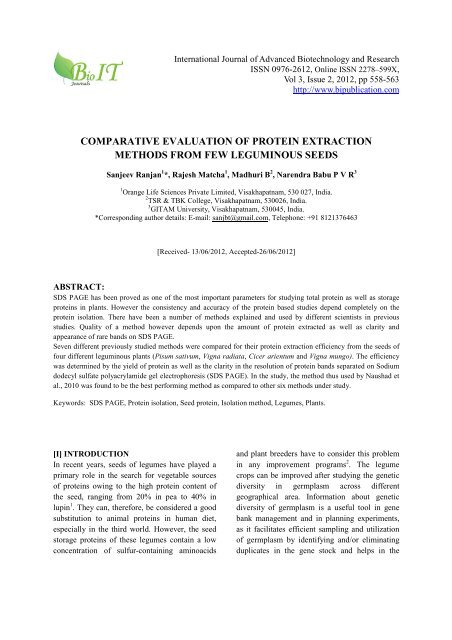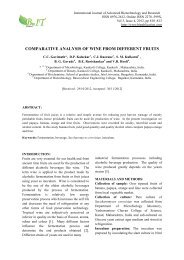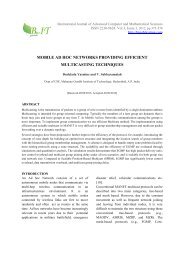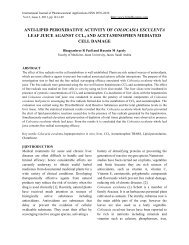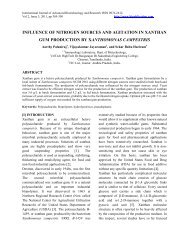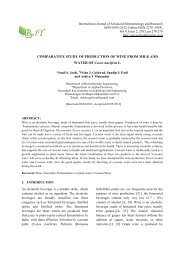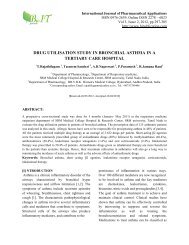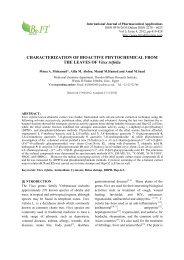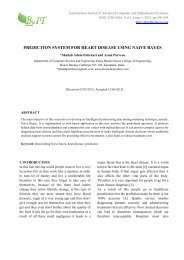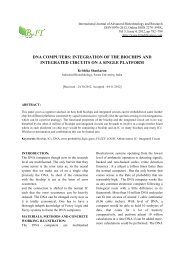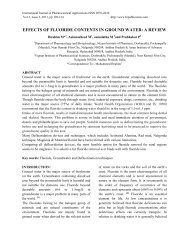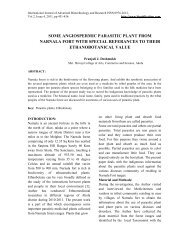comparative evaluation of protein extraction methods from few
comparative evaluation of protein extraction methods from few
comparative evaluation of protein extraction methods from few
Create successful ePaper yourself
Turn your PDF publications into a flip-book with our unique Google optimized e-Paper software.
International Journal <strong>of</strong> Advanced Biotechnology and ResearchISSN 0976-2612, Online ISSN 2278–599X,Vol 3, Issue 2, 2012, pp 558-563http://www.bipublication.comCOMPARATIVE EVALUATION OF PROTEIN EXTRACTIONMETHODS FROM FEW LEGUMINOUS SEEDSSanjeev Ranjan 1 *, Rajesh Matcha 1 , Madhuri B 2 , Narendra Babu P V R 31 Orange Life Sciences Private Limited, Visakhapatnam, 530 027, India.2 TSR & TBK College, Visakhapatnam, 530026, India.3 GITAM University, Visakhapatnam, 530045, India.*Corresponding author details: E-mail: sanjbt@gmail.com, Telephone: +91 8121376463[Received- 13/06/2012, Accepted-26/06/2012]ABSTRACT:SDS PAGE has been proved as one <strong>of</strong> the most important parameters for studying total <strong>protein</strong> as well as storage<strong>protein</strong>s in plants. However the consistency and accuracy <strong>of</strong> the <strong>protein</strong> based studies depend completely on the<strong>protein</strong> isolation. There have been a number <strong>of</strong> <strong>methods</strong> explained and used by different scientists in previousstudies. Quality <strong>of</strong> a method however depends upon the amount <strong>of</strong> <strong>protein</strong> extracted as well as clarity andappearance <strong>of</strong> rare bands on SDS PAGE.Seven different previously studied <strong>methods</strong> were compared for their <strong>protein</strong> <strong>extraction</strong> efficiency <strong>from</strong> the seeds <strong>of</strong>four different leguminous plants (Pisum sativum, Vigna radiata, Cicer arientum and Vigna mungo). The efficiencywas determined by the yield <strong>of</strong> <strong>protein</strong> as well as the clarity in the resolution <strong>of</strong> <strong>protein</strong> bands separated on Sodiumdodecyl sulfate polyacrylamide gel electrophoresis (SDS PAGE). In the study, the method thus used by Naushad etal., 2010 was found to be the best performing method as compared to other six <strong>methods</strong> under study.Keywords: SDS PAGE, Protein isolation, Seed <strong>protein</strong>, Isolation method, Legumes, Plants.[I] INTRODUCTIONIn recent years, seeds <strong>of</strong> legumes have played aprimary role in the search for vegetable sources<strong>of</strong> <strong>protein</strong>s owing to the high <strong>protein</strong> content <strong>of</strong>the seed, ranging <strong>from</strong> 20% in pea to 40% inlupin 1 . They can, therefore, be considered a goodsubstitution to animal <strong>protein</strong>s in human diet,especially in the third world. However, the seedstorage <strong>protein</strong>s <strong>of</strong> these legumes contain a lowconcentration <strong>of</strong> sulfur-containing aminoacidsand plant breeders have to consider this problemin any improvement programs 2 . The legumecrops can be improved after studying the geneticdiversity in germplasm across differentgeographical area. Information about geneticdiversity <strong>of</strong> germplasm is a useful tool in genebank management and in planning experiments,as it facilitates efficient sampling and utilization<strong>of</strong> germplasm by identifying and/or eliminatingduplicates in the gene stock and helps in the
COMPARATIVE EVALUATION OF PROTEIN EXTRACTION METHODS FROM FEW LEGUMINOUS SEEDSestablishment <strong>of</strong> core collection 3-5 . The <strong>protein</strong>pr<strong>of</strong>iling <strong>of</strong> germplasm and use <strong>of</strong> geneticmarkers have been widely and effectively used todetermine the taxonomic and evolutionaryaspects <strong>of</strong> several crops 3-8 .The technique <strong>of</strong> Sodium Dodecyl SulphatePolyacrylamide Gel Electrophoresis (SDS-PAGE) is commonly used for separation <strong>of</strong> seedstorage <strong>protein</strong>s. Seed storage <strong>protein</strong> pr<strong>of</strong>ileshave also been used to study evolutionary relation<strong>of</strong> several crop plants 9 . Sodium DodecylSulphate Polyacrylamide Gel Electrophoresis(SDS-PAGE) is most economical simple andextensively used biochemical technique foranalysis <strong>of</strong> genetic structure <strong>of</strong> germplasm. Asseed storage <strong>protein</strong>s are largely independent <strong>of</strong>environmental fluctuations, their pr<strong>of</strong>iling usingSDS-PAGE technology is particularly consideredas a consistent tool for economic characterization<strong>of</strong> germplasm 10-11 .However there has been always confusion onisolation <strong>methods</strong> for <strong>protein</strong> as differentscientists have used different <strong>methods</strong> for thesame. The goal <strong>of</strong> this study is to compare andsuggest the best performing <strong>protein</strong> isolationmethod <strong>from</strong> seeds belonging to fabaceae family(Legumes).[II] MATERIALS & METHODS2.1. Plant materialFour different types <strong>of</strong> leguminous seeds namelyPisum sativum (PlantA), Vigna radiata (PlantB),Cicer arientum (PlantC) and Vigna mungo(PlantD) were obtained <strong>from</strong> the local farmersnear by Visakhapatnam, Andhra Pradesh. Theseeds were collected dried, were rinsed withdistill water to remove the dust particles and anyother impurities and then dried again for theexperiment.2.2. ReagentsAll the chemicals and reagents used wereresearch grade.2.3. Protein <strong>extraction</strong>Seven different <strong>methods</strong> <strong>of</strong> <strong>protein</strong> <strong>extraction</strong>were carried out, using different buffer solutions.2.3.1. Method1Total <strong>protein</strong>s were extracted by adding 300mg <strong>of</strong>ground seeds in lml <strong>of</strong> 50mM tris-HCI (pH 7.5)and 0.5 M NaCI at 4 0 C for 60 minutes. This wasthen frozen at –20 0 C and thawed 3 times during24h to disrupt the tissue and release the <strong>protein</strong>s(Miller et al., 1972) and centrifugations were at10000 g for 15 min.2.3.2. Method2For <strong>extraction</strong> <strong>of</strong> <strong>protein</strong>s, seeds were groundedin 50 mM phosphate buffer (pH 7.8) andcentrifuged in micro-centrifuge machine for 10min at 14,000rpm (as used by Hameed et al.,2009). The supernatant was separated and usedfor <strong>protein</strong> pr<strong>of</strong>iling.2.3.3. Method3The method suggested previously (Damania etal., 1983) was used as method 3. The grains wereground to fine powder and 10 mg was weighed in1.5 ml micro tube. 400 ml <strong>protein</strong> <strong>extraction</strong>buffer (Tris-HCl 0.05 M, pH 8, 0.02% SDS,30.3% urea, 1% 2-mercaptoethanol) was added toeach micro tube, kept overnight at 40°C andcentrifuged at 13000 rpm for 10 min. Thesupernatant contain dissolved extracted <strong>protein</strong>ready for experiment purposes, which could bekept for longer time at 4°C.2.3.4Method4Seeds were grinded to fine powder with the help<strong>of</strong> mortar and pestle. We added sample buffer(used by Naushad et al., 2010) (400 µl) to a 0.02g <strong>of</strong> fine seed flour as <strong>extraction</strong> liquid andbromophenol blue (BPB) follow the movement <strong>of</strong><strong>protein</strong> in the gel. The active ingredients used forthe <strong>extraction</strong> <strong>of</strong> <strong>protein</strong> buffer contained 0.5 MTris-HCl (pH 8.0), 0.2% SDS, 5 M urea and 1%2-mercaptoethanol. In order to know themovement <strong>of</strong> <strong>protein</strong> in the gel, a dye in the form<strong>of</strong> bromophenol blue was added to the <strong>extraction</strong>buffer. When all these chemicals are tightly puttogether than the solution needs to be purifiedand homogenate, we mixed the samplesthoroughly by vortexing and centrifugation at15,000 rpm for 5 min at room temperature. AfterSanjeev Ranjan, et al. 559
COMPARATIVE EVALUATION OF PROTEIN EXTRACTION METHODS FROM FEW LEGUMINOUS SEEDScentrifuging samples, the crude <strong>protein</strong>s wererecovered as clear supernatant on the top <strong>of</strong> thetube. Then the supernatant were transferred intonew 1.5 ml eppendorf tubes and were stored at -20°C until gel electrophoresis.2.3.5. Method5Protein <strong>extraction</strong> was carried out byhomogenizing the cotyledons in 0.1 M Tris HCLbuffer 7.5pH [16]. Samples <strong>of</strong> supernatantobtained after centrifugation at 17600g at 4 0 C for20 minutes were diluted with sample buffer andloaded in the gel.2.3.6. Method6Seed were routinely prepared by grinding seedsample in buffer used by R.H. Sammour, 1991.Total <strong>protein</strong> extracts were prepared by extractingappropriate <strong>protein</strong> <strong>of</strong> the seed with 0.2 M Tris/HCl, pH 6.8; distilled water and 0.125MTris/borate, pH 8.9. All these extracts werecarried for 24 h at 4°C and then centrifuged at10.000 rpm for 20 min. The supernatant was usedfor electrophoresis.2.3.7. Method7The seeds were pounded in the mortar till theywere powdered finely. 0.5 g seed flour and 1.5ml<strong>of</strong> buffer (suggested by Arulsekar and Parfitt,1986), containing {0.05 M Tris base 6.5 g/L;0.007 M citric acid (monohydrate) 1.5 g/L; 0.1%cysteine hydrochloride 1 g/L; 0.1% ascorbic acid(Na salt or free acid) 1 g/L; 1.0% polyethyleneglycol (H 3500) l0.0 g/L; 1 mM 2-mercaptoethanol 0.08 mL/L, the final pH 8.0}were mixed and homogenized for 1 min.Homogenates in the tubes were transferred intoeppendorf tubes and centrifuged at roomtemperature at 18000 rpm for 20 min.Supernatants were transferred into the neweppendorf tubes and pellets were discarded.2.4. Protein estimationThe <strong>protein</strong>s were determined by Bradford’smethod (Bradford, 1976).2.5. Electrophoresis (SDS PAGE)One dimensional Sodium dodecyl sulfatepolyacrylamide gel were prepared in aconcentration <strong>of</strong> 8% resolving gel and 4.44%stacking gel as suggested by Sambrook et al.(1989). Electrophoresis was carried out accordingto Laemmli (1970) [20] after adding sampleloading buffer. Protein bands were visualized bysilver staining method as described by Blum etal.(1987) [20].[III] RESULTS & DISCUSSIONQuantitative estimation by Bradford’s <strong>protein</strong>estimation revealed that method 7 showed thebest result with plants A, B and C with maximumamount <strong>of</strong> <strong>protein</strong> extracted. In plant D, however,method 4 was the best <strong>extraction</strong> methodquantitatively (Table 1). When SDS PAGE wasused to resolve the extracted <strong>protein</strong>s <strong>few</strong> uniquerevelations were observed.While method 7 was found to maximum yielding<strong>protein</strong> <strong>extraction</strong> method in majority <strong>of</strong> theplants studied, method 4 was established as thebest <strong>extraction</strong> method after electrophoreticstudy.Also method 4 proved to be best yielding methodin plants D. In addition it was the second bestyielding method in all other plants studied.Moreover the SDS PAGE results made it quiteclear that in method 4 maximum numbers <strong>of</strong>bands were observed with minimum backgroundstreaking effect. This proves the quality <strong>of</strong> theextracted <strong>protein</strong> by method 4.The seven different <strong>methods</strong> <strong>of</strong> <strong>protein</strong> <strong>extraction</strong>used in the present study comprised <strong>of</strong> different<strong>extraction</strong> buffer as well as different <strong>methods</strong> <strong>of</strong>cell disruption. It included method whichdepended upon freezing and thawing, methodusing grinding <strong>of</strong> seeds to rupture cellsmechanically. Few <strong>methods</strong> also depended uponchemical lyses <strong>of</strong> cells using detergent. The best<strong>of</strong> the <strong>methods</strong> <strong>of</strong> <strong>protein</strong> <strong>extraction</strong> studied forplant seeds under study was determined asmethod 4. The method 4 actually was acombination <strong>of</strong> chemical as well as mechanical<strong>extraction</strong> procedure which may have resulted inthe enhanced performance. Method 3 howeverused the same buffer as used in method 4 but itSanjeev Ranjan, et al. 560
COMPARATIVE EVALUATION OF PROTEIN EXTRACTION METHODS FROM FEW LEGUMINOUS SEEDSdid not used rough mechanical lyses anddepended entirely on action <strong>of</strong> chemicals onpowdered seeds. This explains the poorperformance <strong>of</strong> method 3 and also proves that the<strong>extraction</strong> buffer alone is not responsible for theperformance <strong>of</strong> a method but it also dependsupon the cell rupture strategy.same molecular weight and therefore notproducing rare <strong>protein</strong> bands. This can besupported by presence <strong>of</strong> many very thick bandsin method 7. Another negative side <strong>of</strong> method 7is high streaking effect hindering the resolution.PlantB:ProteinisolateMethod7 0.470* 0.590* 0.510* 0.440Table 1: Amount <strong>of</strong> <strong>protein</strong> yield <strong>from</strong> plant seedsunder study using different <strong>methods</strong> (* denotes themaximum <strong>protein</strong> yield)PlantA:Amount <strong>of</strong> <strong>protein</strong> per gram <strong>of</strong> seed (inmg)PisumsativumVignaradiateCicerarientumVignamungoMethod1 0.146 0.173 0.148 0.170Method2 0.200 0.210 0.190 0.230Method3 0.080 0.092 0.060 0.010Method4 0.280 0.360 0.300 0.480*Method5 0.150 0.190 0.270 0.140Method6 0.170 0.140 0.120 0.1801 2 3 4 5 6 7Fig: Protein bands <strong>of</strong> Plant B on SDS PAGE (Proteinextracted by 1-7 different <strong>methods</strong>)PlantC:7 1 2 3 4 5 6Fig: Protein bands <strong>of</strong> Plant A on SDS PAGE (Proteinextracted by 1-7 different <strong>methods</strong>)Another method (method 7) was found to beextracting maximum amount <strong>of</strong> <strong>protein</strong> in most <strong>of</strong>the plants studied was not found to be holdingthat good when studied on SDS PAGE. This canbe explained as the <strong>extraction</strong> <strong>of</strong> <strong>protein</strong>s with1 2 3 4 5 6 7Fig: Protein bands <strong>of</strong> Plant C on SDS PAGE (Proteinextracted by 1-7 different <strong>methods</strong>)Sanjeev Ranjan, et al. 561
COMPARATIVE EVALUATION OF PROTEIN EXTRACTION METHODS FROM FEW LEGUMINOUS SEEDSPlantD:1 2 3 4 5 6 7Fig: Protein bands <strong>of</strong> Plant D on SDS PAGE (Proteinextracted by 1-7 different <strong>methods</strong>)[IV] CONCLUSIONIn conclusion, the method 7 (Naushad et.al, 2010)[15] was determined as the best method for<strong>protein</strong> <strong>extraction</strong> taking into consideration, the<strong>protein</strong> yield and the SDS-PAGE resolution.Although the study was conducted upon a set <strong>of</strong>leguminous plants, a similar result can beexpected for <strong>protein</strong> isolation <strong>from</strong> seeds <strong>of</strong> otherplants.ACKNOWLEDGEMENTThe authors acknowledged the support <strong>from</strong> Orange Lifesciences Pvt Ltd, Visakhapatnam for providing the necessaryresearch facilities.REFERENCES:1. Cereletti, P. [1979] The Legume Proteins. Proc.Congr. PPI. 30 May-2 June, Perugia, Italy. Pp. 31-57.2. Summerfield, R.J., and Roberts, E.H. [1985]“Grain Legume Crops”. Collins Pub. London,UK.3. Ghafoor, A. and Z. Ahmad. [2005] Diversity <strong>of</strong>agronomi traits and total seed <strong>protein</strong> in blackgram Vigna mungo (L.) hepper. Acta BiologiaCracoviensia series Botanica, 47: 69-75.4. Ghafoor, A., F.N. Gulbaaz, M. Afzal, M. Ashrafand M. Arshad. [2003] Inter-relationship betweenSDS-PAGE markers and agronomic traits inchickpea (Cicer arietinum L.). Pak. J. Bot., 35:613-624.5. Ghafoor, A., Z. Ahmad, A.S. Qureshi and M.Bashir. [2002] Genetic relationship in Vignamungo (L.) Hepper and V. radiata (L.) R. Wilczekbased on morphological traits and SDS- PAGE.Euphytica, 123: 367-378.6. Murphy, R.W., J.W. Sites, D.G. Buth and C.H.Haufler. [1990] Protein I: IsozymeElectrophoresis. In: Molecular Systematics.(Eds.): D.H. Hillis and C. Moritz, pp. 45-126.Sinauer Assoc., Sunderland, MA.7. Khan, M.K. 1990. Production and utility <strong>of</strong>chickpea (Cicer arietinum L.) in Pakistan.Progressive Farming, 10: 28-33.8. Das, S. and K.K. Mukarjee. 1995. Comparativestudy on seed <strong>protein</strong>s <strong>of</strong> Ipomoea. Seed Sci. &Technol., 23: 501-509.9. Ravi M, Geethanjali S, Sameeyafarheen F,Maheswaran M (2003). Molecular marker basedgenetic diversity analysis in rice (Oryza sativa L.)using RAPD and SSR markers. Euphytica. 133:243-252.10. Javid, A., A. Ghafoor and R. Anwar. 2004. Seedstorage <strong>protein</strong> electrophoresis in groundnut forevaluating genetic diversity. Pak. J. Bot., 36: 87-96.11. Iqbal, S.H., A. Ghafoor and N. Ayub. 2005.Relationship between SDS-PAGE markers andAscochyta blight in chickpea. Pak. J. Bot., 37: 87-96.12. Miller MK, Schonhorst MH, McDaniel RG.[1972] Identification <strong>of</strong> hybrids <strong>from</strong> alfalfacrosses by electrophoresis <strong>of</strong> single seed <strong>protein</strong>s.Crop Science 12:535–537.13. Hameed A., Shah T. M., Atta B. M., Iqbal N.,Haq M.A., Ali Hina., [2009] Comparative seedstorage <strong>protein</strong> pr<strong>of</strong>iling <strong>of</strong> Kabuli genotypes.Pak. J. Bot., 41(2): 703-710.14. Damania A. B., Porceddu E., Jackson M. T.[1983] A rapid method for the <strong>evaluation</strong> <strong>of</strong>variation in germplasm collection <strong>of</strong> cereals usingSanjeev Ranjan, et al. 562
COMPARATIVE EVALUATION OF PROTEIN EXTRACTION METHODS FROM FEW LEGUMINOUS SEEDSpolyacrylamide gel electrophoresis. Euphytica,32: 887-883.15. Naushad Ali Turi, Farhatullah, M. Ashiq Rabbani,Naqib Ullah Khan, M. Akmal, Zahida HassanPervaiz, M. Umair Aslam. [2010] Study <strong>of</strong> totalseed storage <strong>protein</strong> in indigenous Brassicaspecies based on sodium dodecyl sulphatepolyacrylamide gel electrophoresis (SDS-PAGE).African Journal <strong>of</strong> Biotechnology, Vol. 9(45):7595-7602.16. S.S. Jha, D Ohri. [2002] Comparative study <strong>of</strong>seed <strong>protein</strong> pr<strong>of</strong>iles in genus Pisum. BiologiaPlantarum, Vol. 45(4): 529-532.17. Sammour R. H., [1991] Using electrophoresistechniques in varietal identification, biosystematicanalysis, phylogenetic relations and geneticresources management. Journal <strong>of</strong> IslamicAcademy <strong>of</strong> Sciences., 4:3, 221-226.18. Arulsekar, S. and D. E. Parfitt, [1986] Isozymeanalysis procedures for stone fruits, almond,grape, walnut, pistachio and fig. Hortscience, 21:928-933.19. Bradford, M.M. [1976] A rapid and sensitivemethod for the quantitation <strong>of</strong> microgramquantities <strong>of</strong> <strong>protein</strong> utilizing the principle <strong>of</strong><strong>protein</strong>-dye binding. Ann. Biochem., 72: 248-254.20. Laemmli, U.K. [1970] Cleavage <strong>of</strong> structure<strong>protein</strong>s assembly <strong>of</strong> the head <strong>of</strong> bacteriophageT4. Nature, 22: 680-685.21. Sambrook, J., E.F. Fritsch, and T. Maniatis. 1989.Molecular Cloning: A Laboratory Manual, 2nded., Cold Spring Harbor Laboratory Press,Plainview, NY.22. Blum,H., Beier,H. and Gross,H.J. [1987]Improved silver staining <strong>of</strong> plant <strong>protein</strong>s, RNAand DNA in polyacrylamide gels. Electrophoresis8, 93-99Sanjeev Ranjan, et al. 563


